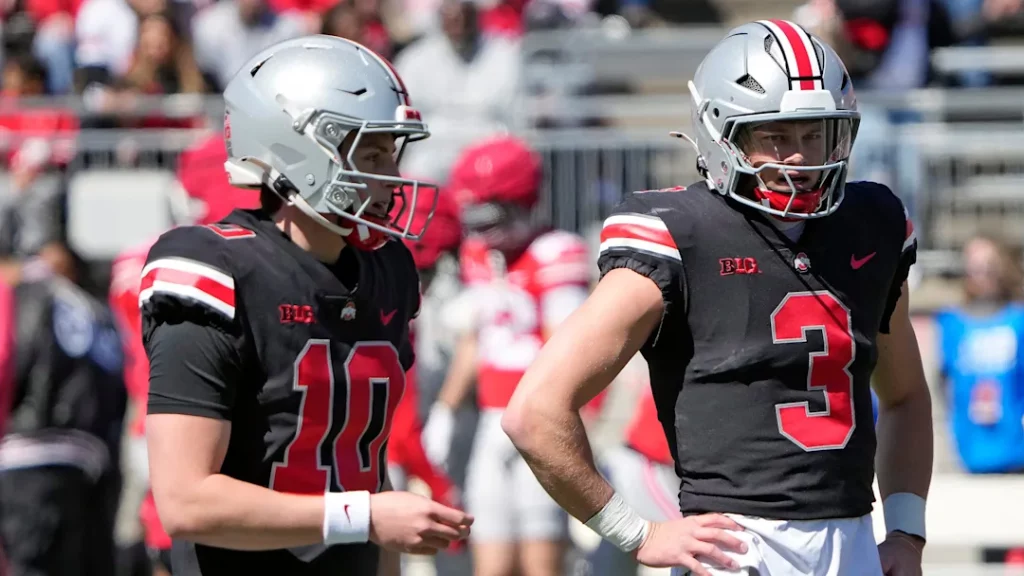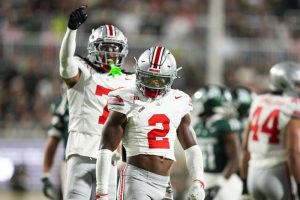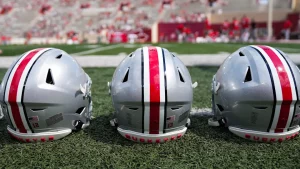
The Ohio State Buckeyes have long been synonymous with football excellence, a program steeped in tradition, boasting national championships, Heisman Trophy winners, and a pipeline to the NFL. Year after year, they remain one of the most dominant forces in college football, perpetually competing for conference titles and national glory. So when news broke that the Buckeyes had been included on an ESPN list they definitely do not want to be part of, it sent shockwaves through the college football world—and particularly through Columbus, Ohio.
The list in question was ESPN’s latest “Most Disappointing College Football Programs of the Season,” an annual ranking that highlights top teams who failed to meet expectations. For a program with Ohio State’s lofty goals and storied history, making this list is akin to being called out publicly for underperforming. It signals not only lost games but also missed opportunities, questionable decisions, and a potential decline in program prestige.
This inclusion comes at a time when Ohio State fans, alumni, and supporters had hoped to be celebrating a season filled with success and progress. Instead, the Buckeyes have faced an onslaught of criticism, not only from national media but also from within their own fan base. The disappointment runs deep because Ohio State’s standards are so high—anything less than competing for the College Football Playoff and a shot at a national title is perceived as a failure. It is the burden of a blue-blood program to consistently deliver, and falling short is met with harsh scrutiny.
To understand why Ohio State was placed on this infamous ESPN list, it is necessary to examine the factors contributing to the Buckeyes’ disappointing season. While they have fielded a talented roster and enjoyed early success in the year, a combination of injuries, coaching decisions, and uncharacteristic losses culminated in a campaign that left many questioning the program’s direction.
One of the most glaring issues has been Ohio State’s inconsistency. The Buckeyes have shown flashes of brilliance at times but were unable to sustain momentum throughout the season. They suffered losses against teams they were heavily favored to beat, including an embarrassing home defeat that stunned fans and analysts alike. These losses exposed weaknesses in both offensive execution and defensive resilience, areas that Ohio State historically prides itself on.
Injuries also played a major role in Ohio State’s struggles. Key players missed significant time, forcing backups into starting roles before they were fully ready. While depth is supposed to be a hallmark of elite programs, the absence of veteran leadership on the field contributed to erratic play and missed assignments. The physical toll of the season tested the team’s ability to adapt, and unfortunately, the Buckeyes were not always up to the challenge.
Off the coaching front, questions have surfaced about play calling and game management. Head Coach Ryan Day, who had built a reputation as a rising star in the coaching world, faced criticism for decisions that seemed overly conservative or, conversely, too risky without proper execution. Some fans and commentators have speculated whether the pressure of high expectations is affecting the coaching staff’s ability to make optimal choices under duress.
Moreover, there has been talk about team morale and internal dynamics. Reports of frustration among players and staff hint at possible communication breakdowns and an unclear vision for how to turn the season around. While these behind-the-scenes elements are difficult to quantify, they often manifest on the field in subtle ways that can tip close games against Ohio State’s favor.
The reality is that making ESPN’s “Most Disappointing” list is a blow not just because of the public perception but because it underscores a gap between potential and performance. Ohio State possesses all the ingredients necessary for success: talented athletes, experienced coaching, top-tier facilities, and a passionate fan base. Yet, the program’s failure to translate these advantages into wins on crucial nights has led to an undeniable disappointment.
It’s worth noting that Ohio State’s inclusion on this list is not an isolated event but rather a reflection of a larger pattern that has caused concern among fans. The Buckeyes have not won a national championship since 2014, and in recent years, they have stumbled in the College Football Playoff, unable to get over the hump. While reaching the playoff consistently is an accomplishment in itself, the expectations at Ohio State are championship or bust, and falling short repeatedly erodes confidence.
This season’s struggles are particularly frustrating given the high expectations surrounding the team coming in. Ohio State was ranked among the top teams in preseason polls, touted as a favorite to win the Big Ten and make a deep playoff run. The roster included several NFL-caliber players, including a dynamic quarterback, standout wide receivers, and a defensive line known for its ferocity. Yet, despite the talent, the team’s execution often lacked cohesion.
Fans have taken to social media to express their disappointment and hold the program accountable. Memes and viral posts lamenting Ohio State’s unexpected losses and perceived underachievement have flooded platforms like Twitter and Instagram. This public outcry is a double-edged sword; while it demonstrates passionate support for the team, it also amplifies the pressure on players and coaches to perform.
Analysts have pointed out that the Big Ten Conference itself has become more competitive, with multiple programs rising to challenge Ohio State’s dominance. Schools like Michigan, Penn State, and Wisconsin have fielded strong teams capable of beating the Buckeyes on any given day. This heightened competition means that Ohio State can no longer rely solely on its reputation and must prove itself game after game.
Another factor contributing to Ohio State’s struggles is the evolving landscape of college football, including the transfer portal and NIL (Name, Image, Likeness) deals. The transfer portal has made player movement more fluid, and Ohio State has had to navigate retaining key contributors while integrating newcomers. Similarly, the NIL era has introduced new distractions and opportunities for athletes, complicating team chemistry. How well the Buckeyes manage these challenges could determine their future success.
Despite the disappointment, there is a silver lining. Ohio State’s inclusion on ESPN’s “Most Disappointing” list could serve as a wake-up call. History shows that elite programs often face adversity and use it as motivation to regroup and improve. The Buckeyes have the resources and culture to rebound, provided they take a hard look at what went wrong and address those issues head-on.
Some players have already publicly committed to working harder and focusing on team goals rather than individual accolades. The coaching staff has emphasized learning from mistakes and making adjustments in practice and game planning. Ohio State’s recruiting remains strong, and fresh talent will be arriving next season to bolster the roster.
The bigger question is whether the program’s leadership can successfully navigate this turbulent period and restore the winning mentality that Ohio State is known for. The fans demand it, the alumni expect it, and the players want it. But it will take more than just talent on paper—it requires discipline, unity, and a relentless pursuit of excellence.
Ohio State’s appearance on ESPN’s “Most Disappointing College Football Programs” list is a tough pill to swallow, but it also represents an opportunity for growth. The Buckeyes have a long history of overcoming obstacles and rising back to prominence. If the lessons of this challenging season are taken seriously, Ohio State could emerge stronger, more focused, and ready to reclaim its place among college football’s elite.
In the end, no team wants to be labeled as disappointing—especially one with Ohio State’s pedigree. But sometimes, facing such harsh realities is necessary to spark change. As the season concludes and the Buckeyes regroup in the offseason, all eyes will be on Columbus to see how this proud program responds. Will they allow this setback to define them, or will it fuel a comeback story worthy of their storied legacy?
Only time will tell. But one thing is certain: Ohio State is not a program that stays down for long. The Buckeyes will be back, hungry and determined, ready to erase this disappointing chapter from memory and add new chapters filled with triumph and glory.





